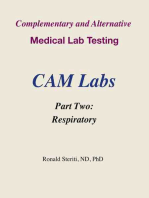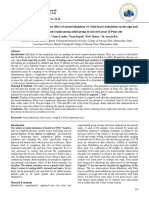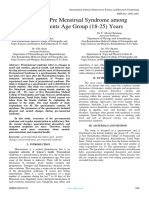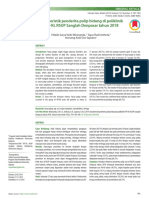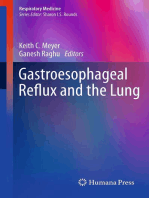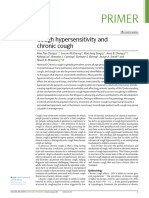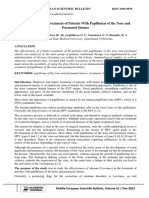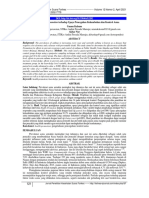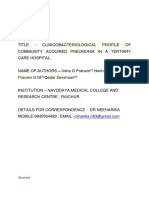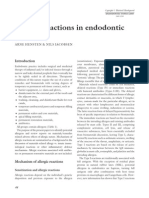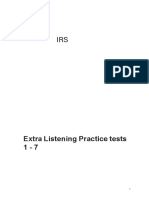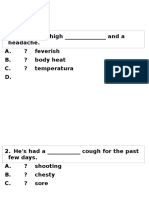Professional Documents
Culture Documents
Evaluation of Bronchial Asthma Among Females Age Group (18-25) Years
Copyright
Available Formats
Share this document
Did you find this document useful?
Is this content inappropriate?
Report this DocumentCopyright:
Available Formats
Evaluation of Bronchial Asthma Among Females Age Group (18-25) Years
Copyright:
Available Formats
Volume 7, Issue 11, November – 2022 International Journal of Innovative Science and Research Technology
ISSN No:-2456-2165
Evaluation of Bronchial Asthma among
Females Age Group (18-25) Years
Dr.R.Anusha1, Dr.P.Priya2, Dr. P. Allwin Christuraj3, Dr. S. Eswin sini4, Dr.D.Jobila5
Professor1, Associate Professor2,3,4,5
Department of Naturopathy , Department of Community Medicine2, Department of Massage and Aromatherapy3,
1
Department of Yoga4, Department of Psychology5
Sree Ramakrishna Medical College of Naturopathy and Yogic Sciences and Hospital, Kulasekharam, (T.N.) India
Abstract:- Asthma remains the most common chronic II. PATHOPHYSIOLOGY
respiratory disease in India. Although asthma is often
believed to be a disorder localized to the lungs. Asthma The Pathogenesis of bronchial asthma is an extrinsic,
frequently co-exists with other atopic disorders, intrinsic, and mixed pattern. In the extrinsic pattern, it is an
particularly allergic rhinitis. World wide 80% of asthma allergic, atopic. This is characterized by personal or family
deaths occur in low and middle-income countries. The history. Rhinitis, urticaria, or infantile eczema, are the
prevalence of asthma in India is about 3%, 2.4% in symptoms. In this condition, there is an increased level of
adults, and 20% in children. This study was conducted IgE in the serum. The intrinsic pattern is idiosyncratic and
to assess bronchial asthma among females age group (18 non atopic. It occurs later in adult age, with negative
- 25) years at Sree Ramakrishna Medical College of personal or family history of allergy and negative skin test
Naturopathy and Yogic Sciences and Hospital, normal serum level of IgE. In mixed patterns, many persons
Kulasekharam, Tamil Nadu, India. Verbal consent was do not fit into both categories but have mixed features of
taken from the females by explaining the purpose of the both. The triggers that cause asthma attacks are air pollution,
study. The total number of study respondents was 30. dust mites, exercise, pets, smoking, strong chemical smell,
The questionnaire contains 30 questions. The parameters and also due to other occupational exposure, and hereditary
of the questionnaire included respiratory disturbances, factors. The symptoms of bronchial asthma are, cough,
gastrointestinal discomfort, skin infection, stress, pain, wheezing, allergic rhinitis, breathing difficulty, chest pain,
and medication.This study shows and concluded that, headache, fever, tiredness, and restlessness.
females are aware about the bronchial asthma, but need
more awareness about prevention of allergy symptoms III. MATERIALS AND METHOD
and mental hygiene and also should improve the indoor The study is designed as a questionnaire and is
and outdoor hygiene. distributed to the female age group (18 - 25) years at Sree
Keywords:- Bronchial asthma, dust allergy, common cold. Ramakrishna Medical College of Naturopathy and Yogic
Sciences and Hospital, Kulasekharam, Tamil Nadu, India.
I. INTRODUCTION Verbal consent was taken from the females by explaining
the purpose of the study. The total number of study
Asthma remains the most common chronic respiratory respondents was 30. The questionnaire contains 30
disease in India. Although asthma is often believed to be a questions. The parameters of the questionnaire included
disorder localized to the lungs. Current evidence indicates respiratory disturbances, gastrointestinal discomfort, skin
that it represents the component of systemic airway disease infection, stress, pain, and medication. Those females who
involving the entire respiratory tract, and asthma frequently did not cooperate and non-willing participants were
co-exists with other atopic disorders, particularly with excluded from the study.
allergic rhinitis. Asthma is said to be a chronic inflammatory
disease of the airways and it is characterized by increased IV. RESULT
responsiveness of the trachea to a variety of stimuli resulting
in widespread spasmodic narrowing of the air passages, The respondents were between the age group of (18 -
which may be relieved spontaneously or by therapy. World 25) years. The total number of females is n=30. Table 1
wide 80% of asthma deaths occur in low and middle-income shows, Affected with asthma attack 10(33.33%), and
countries. The prevalence of asthma in India is about 3%, 20(66.66%) do not have asthma attack. Throat Infection
2.4% in adults, and 20% in children. The factors that frequently 8(26.66%), while 22(73.33%) do not have throat
stimulate asthma attacks are air pollution, dust mites, Infection frequently. Affected with dry cough 8(26.66%),
exercise, pets, smoking, strong chemical smell, hereditary and 22(73.33%) do not have affected with dry cough.
factors and also due to other occupational exposure. Common cold frequently 14(46.66%), and 16(53.33%) do
not affected with common cold frequently. Breathing
difficulty with cough 6(20%), while 24(80%) do not have
breathing difficulty with cough. Parents affected with
bronchial asthma 4(13.33%), and 26(86.66%) parents are
not affected with bronchial asthma. Females undergone
Lung Function Test 4(13.33%), and 26(86.66%) ) do not
undergone Lung Function Test.
IJISRT22NOV1026 www.ijisrt.com 1901
Volume 7, Issue 11, November – 2022 International Journal of Innovative Science and Research Technology
ISSN No:-2456-2165
S.NO CONTENTS YES(%) NO(%)
1 Are you affected with Asthma Attack 10(33.33%) 20(66.66%)
2 Throat Infection Frequently 8(26.66%) 22(73.33%)
3 Affected with Dry Cough 8(26.66%) 22(73.33%)
4 Common Cold Frequently 14(46.66%) 16(53.33%)
5 Breathing Difficulty with Cough 6(20%) 24(80%)
6 Parents affected in bronchial asthma 4(13.33%) 26(86.66%)
7 Lung Function Test 4(13.33%) 26(86.66%)
8 While Climbing the Staircase, do you feel Breathing Difficulty 11(36.66%) 19(63.33%)
9 After a long Walk did you feel gasping Breathing 10(33.33%) 20(66.66%)
10 Do you feel Chest Tightness while wear Tight Clothes 18(60%) 12(40%)
11 While exercise do you feel Breathing difficulty 9(30%) 21(70%)
12 While Speaking are you feel Breathing Difficulty 6(20%) 24(80%)
13 In Physical activity, do you feel Breathing difficulty 14(46.66%) 16(53.33%)
14 Do You Feel Wheezing Sound 11(36.66%) 19(63.33%)
15 Climatic Changes can Cause Breathing Difficulty 9(30%) 21(70%)
16 Are you Experienced with Breathing Difficulty 13(43.33%) 17(56.66%)
17 Climatic Changes can cause Common Cold 21(70%) 9(30%)
Table: 1: Respiratory disturbances during asthmatic condition
Breathing difficulty while climbing the staircase speaking. Have breathing difficulty during physical activity
11(36.66%) and 19(63.33%) do not feel breathing difficulty 14(46.66%) and 16(53.33%) do not have breathing difficulty
while climbing the staircase. After a long walk feels gasping during physical activity. Having wheezing sounds
breathing 10(33.33%), and 20(66.66%) do not feel gasping 11(36.66%) and 19(63.33%) do not have wheezing sounds.
breathing. Chest tightness while wearing tight clothes Climatic changes can cause breathing difficulty 9(30%), and
18(60%), and 12(40%) do not have this symptom. Getting 21(70%) ) do not have breathing difficulty while climatic
breathing difficulty while doing exercise 9(30%) and changes. Have experience breathing difficulty 13(43.33%)
21(70%) do not have breathing difficulty while doing and 17(56.66%) do not experienced breathing difficulty.
exercise. Have breathing difficulty while speaking 6(20%), Climatic changes can cause the common cold 21(70%) and
and 24(80%) do not have breathing difficulty while 9(30%) do not have a common cold while climatic changes.
S.NO CONTENTS YES(%) NO(%)
1 Are You suffer with Constipation 7(23.33%) 23(76.66%)
2 Do You have Food Allergy 2(6.66%) 28(93.33%)
Table 2: Gastro intestinal discomforts during asthmatic Condition
Table: 2 shows, suffered with constipation 7(23.33%), while 23(76.66%) do not have suffered with constipation. Have
food allergy 2(6.66%), and 28(93.33%) do not have food allergy.
S.NO CONTENTS YES(%) NO(%)
1 Dust allergy 19(63.33%) 11(33.33%)
2 Early Morning Allergy Symptoms 13(43.33%) 17(56.66%)
Table 3: Allergy symptoms during asthmatic condition
Table: 3 shows, dust allergy 19(63.33%), and 11(33.33%) do not have dust allergy . Early morning allergy symptoms
13(43.33%) and 17(56.66%) do not have early morning allergy symptoms.
S.NO CONTENTS YES(%) NO(%)
1 During stress are you feel heaviness on Chest 7(23.33%) 23(76.66%)
2 During Stress are you feel Breathing Difficulty 3(10%) 27(90%)
Table 4: Stress during asthmatic condition
Table: 4 shows, during stress, getting heaviness in chest 7(23.33%) and 23(76.66%) do not have this symptom. Have
breathing difficulty during stress 3(10%) and 27(90%) do not have this symptom.
S.NO CONTENTS YES(%) NO(%)
1 Are you using Inhaler 6(20%) 24(80%)
2 Steroid injection or Oral Medication 9(30%) 21(70%)
Table 5: Medication during asthmatic condition
Table: 5 shows, using Inhaler 6(20%), and do not use inhaler 24(80%). Steroid injection or oral medication 9(30%), and
21(70%) do not use steroid injection or oral medication.
IJISRT22NOV1026 www.ijisrt.com 1902
Volume 7, Issue 11, November – 2022 International Journal of Innovative Science and Research Technology
ISSN No:-2456-2165
S.NO CONTENTS YES(%) NO(%)
1 Affected with Sinusitis 7(23.33%) 23(76.66%)
2 Any Limitation in Physical activities 5(16.66%) 25(83.33%)
3 Travel in Public Transport frequently 14(46.66%) 16(53.33%)
4 Are you feel Headache 10(33.33%) 20(66.66%)
5 Do you have Skin Infection 3(10%) 27(90%)
Table 6: other symptoms during asthmatic condition
Table: 6 shows the other symptoms, being affected by [5.] Kang HR, Choi GS, Park SJ, et al. The effects of
sinusitis 7(23.33%) and 23(76.66%) do not affect by bronchiectasis on asthma exacerbation. Tuberc Respir
sinusitis. Any limitation in physical activities 5(16.66%) and Dis 2014. (Google Scholar)
25(83.33%) do not have any limitations in physical [6.] Evans SA, Turner SM, Bosch BJ, et al. Lung function
activities. Travel in public transport frequently 14(46.66%) in bronchiectasis: the influence of Pseudomonas
and 16(53.33%) do not travel in public transport frequently. aeruginosa. Eur Respir J 1996. (Google Scholar)
Have headache 10(33.33%), and 20(66.66%) do not feel [7.] Effect of physical training on airway inflammation in
headache. Have skin Infection 3(10%), and 27(90%) do not bronchial asthma: a systematic review.Smita
have skin Infection. Pakhale, Vanessa Luks, Andrew Burkett & Lucy
TurnerBMC Pulmonary Medicine 2013.
V. DISCUSSION [8.] Boyd AW, Estell K, Dransfield M, Schwiebert L: The
effect of aerobic exercise on asthma-related responses
Affected in asthma attack 10(33.33%), fewer females in adults. J Allergy Clin Immunol. 2011
affected in an asthma attack. Common cold frequently [9.] E, Bonetto G, Zachello F, Filippone M. Low exhaled
14(46.66%), more females having the symptoms of common nitric oxide in school-age children with
cold frequently. While climbing the staircase, fewer females bronchopulmonary dysplasia and airflow
feel breathing difficulty 11(36.66%). Climatic changes can limitation. Am J Respir Crit Care Med. 2005.
cause breathing difficulty 9(30%). Chest tightness while (Google Scholar)
wearing tight clothes 18(60%), majority of females have this [10.] Cook J, Beresford F, Fainardi V, Hall P, Housley G,
symptom. Have breathing difficulty during physical activity Jamalzadeh A, et al. Managing the paediatric patient
14(46.66%), most of the females have this symptom. Fewer with refractory asthma: a multidisciplinary
female feels wheezing sound 11(36.66%). Experienced with approach. J Asthma Allergy. (2017). (Google
breathing difficulty 13(43.33%), suffer with constipation Scholar)
7(23.33%). fewer females suffer from constipation. Dust
allergy 19(63.33%), majority of the females having dust
allergy. Early morning allergy Symptoms 13(43.33%), more
females have morning allergy Symptoms. During stress,
getting heaviness in chest 7(23.33%), fewer females have
this symptom. Steroid injection or oral medication 9(30%),
most of the females have steroid injection or oral
medication. Most of the females have sinusitis 7(23.33%)
and 10(33.33%) headache.
VI. CONCLUSION
This study shows and concluded that females are
aware of bronchial asthma, but need more awareness about
the prevention of allergy symptoms and mental hygiene and
should improve indoor and outdoor hygiene. Need more
awareness about asthma triggers.
REFERENCES
[1.] Basu S. Dimensions of tribal health in India. Health
Popul Perspect Issues. 2000. (Google Scholar)
[2.] India Ministry of Tribal Affairs. The national tribal
policy (draft). New Delhi, India: India Ministry of
Tribal Affairs, 2004.
[3.] Test book of pathology Harsh mohan, Page 491- 492.
Edition
[4.] Bateman ED, Hurd SS, Barnes PJ, et al. Global
strategy for asthma management and prevention:
GINA executive summary. Eur Respir J. 2008.
IJISRT22NOV1026 www.ijisrt.com 1903
You might also like
- Evaluation of Urinary Tract Infection Among Females Age Group (18 - 22) YearsDocument4 pagesEvaluation of Urinary Tract Infection Among Females Age Group (18 - 22) YearsInternational Journal of Innovative Science and Research TechnologyNo ratings yet
- Complementary and Alternative Medical Lab Testing Part 2: RespiratoryFrom EverandComplementary and Alternative Medical Lab Testing Part 2: RespiratoryNo ratings yet
- An Assessment On Acne in Young Women in The Age Group of 18-25 Years A Study From Tamilnadu, IndiaDocument3 pagesAn Assessment On Acne in Young Women in The Age Group of 18-25 Years A Study From Tamilnadu, IndiaInternational Journal of Innovative Science and Research TechnologyNo ratings yet
- A Comparative Study To Assess The Effect of Steam Inhalation V/s Tulsi Leaves Inhalation On The Sign and Symptoms of Cold and Cough Among Adult Group in Selected Areas of Pune CityDocument3 pagesA Comparative Study To Assess The Effect of Steam Inhalation V/s Tulsi Leaves Inhalation On The Sign and Symptoms of Cold and Cough Among Adult Group in Selected Areas of Pune CityLisa Dewi NandikasariNo ratings yet
- Jurnal Reading Kelompok Allergy FixDocument24 pagesJurnal Reading Kelompok Allergy FixWan fitria nurdilaNo ratings yet
- Studi Efektifitas Biaya Terkait Pemilihan Obat Asma Bronkiale Rawat Inap Di Suatu Rumah Sakit Swasta Di SurabayaDocument9 pagesStudi Efektifitas Biaya Terkait Pemilihan Obat Asma Bronkiale Rawat Inap Di Suatu Rumah Sakit Swasta Di SurabayaElma DiahNo ratings yet
- 3 MKG RG AK SKS 2017 65 JBPR Review 32-36Document6 pages3 MKG RG AK SKS 2017 65 JBPR Review 32-36Adriel SebastianNo ratings yet
- Correlation Between Asthma And: Internal Medicine - PediatricsDocument4 pagesCorrelation Between Asthma And: Internal Medicine - PediatricsMaría Sol López MNo ratings yet
- 93-Article Text-364-2-10-20200328Document6 pages93-Article Text-364-2-10-20200328gocelij948No ratings yet
- Chronic Cough in Children: Causes and TreatmentDocument8 pagesChronic Cough in Children: Causes and TreatmentNajla N ShNo ratings yet
- Asthma in elderly patientsDocument6 pagesAsthma in elderly patientsbrakim23No ratings yet
- Journal Homepage: - : IntroductionDocument6 pagesJournal Homepage: - : IntroductionIJAR JOURNALNo ratings yet
- Appendix MicrobiotaDocument3 pagesAppendix MicrobiotaVivek VivekNo ratings yet
- DR Artana 3Document8 pagesDR Artana 3novinnaNo ratings yet
- Evaluation of Pre Menstrual Syndrome Among Female Students Age Group (18-25) YearsDocument4 pagesEvaluation of Pre Menstrual Syndrome Among Female Students Age Group (18-25) YearsInternational Journal of Innovative Science and Research TechnologyNo ratings yet
- KlasifikasiDocument8 pagesKlasifikasinurul sachrani putriNo ratings yet
- Disentri AmubaDocument8 pagesDisentri AmubaVivi DeviyanaNo ratings yet
- Evaluation of Stress Among Females Age Group (18 - 25) YearsDocument3 pagesEvaluation of Stress Among Females Age Group (18 - 25) YearsInternational Journal of Innovative Science and Research TechnologyNo ratings yet
- Epidemiological Study of Entamoeba Histolytica Among Children in Nasiriyah City, Thi-Qar, IraqDocument10 pagesEpidemiological Study of Entamoeba Histolytica Among Children in Nasiriyah City, Thi-Qar, IraqCentral Asian StudiesNo ratings yet
- Jurnal Kesehatan: Hubungan Antara Profil Dermatoglifi Mahasiswa Penderita Asma Dengan Indeks Prestasi Mahasiswa (IPK)Document9 pagesJurnal Kesehatan: Hubungan Antara Profil Dermatoglifi Mahasiswa Penderita Asma Dengan Indeks Prestasi Mahasiswa (IPK)Nova RizkenNo ratings yet
- Risk Factors and Prevalence of Catamenial Asthma (Perimenstrual Asthma, Pma) : A Cross-Sectional StudyDocument10 pagesRisk Factors and Prevalence of Catamenial Asthma (Perimenstrual Asthma, Pma) : A Cross-Sectional StudyIJAR JOURNALNo ratings yet
- 18 FullDocument12 pages18 FulltalithaNo ratings yet
- Factors Related To Severe Acute Asthma Attack and Treatment: IJPSR (2012), Vol. 3, Issue 08 (Research Article)Document4 pagesFactors Related To Severe Acute Asthma Attack and Treatment: IJPSR (2012), Vol. 3, Issue 08 (Research Article)Tanvir HayderNo ratings yet
- 503-Article Text-2638-1-10-20231004 3Document12 pages503-Article Text-2638-1-10-20231004 3Nur Wahdania PutriNo ratings yet
- Clinical Study: Primary Atrophic Rhinitis: A Clinical Profile, Microbiological and Radiological StudyDocument7 pagesClinical Study: Primary Atrophic Rhinitis: A Clinical Profile, Microbiological and Radiological StudyAmira TauhidaNo ratings yet
- The Gender, Age and Risk Factor Distribution Differs in Self-Reported Allergic and Non-Allergic Rhinitis: A Cross-Sectional Population-Based StudyDocument9 pagesThe Gender, Age and Risk Factor Distribution Differs in Self-Reported Allergic and Non-Allergic Rhinitis: A Cross-Sectional Population-Based StudyChristian ThamNo ratings yet
- Respiratory and Gastrointestinal Complications of Caustic Ingestion in ChildrenDocument3 pagesRespiratory and Gastrointestinal Complications of Caustic Ingestion in ChildrenramadanNo ratings yet
- Journal ReadingDocument14 pagesJournal ReadingDesrainy InhardiniNo ratings yet
- Jurnal 1Document8 pagesJurnal 1Silvia Yesi ElfarianiNo ratings yet
- Otomycosis ChildrenDocument3 pagesOtomycosis ChildrenMei Risanti SiraitNo ratings yet
- Karakteristik Penderita Polip Hidung Di Poliklinik THT-KL RSUP Sanglah Denpasar Tahun 2018Document4 pagesKarakteristik Penderita Polip Hidung Di Poliklinik THT-KL RSUP Sanglah Denpasar Tahun 2018firliNo ratings yet
- JR RhinoDocument24 pagesJR RhinoZiha Zia Leonita FauziNo ratings yet
- Research About:: by Group 6Document11 pagesResearch About:: by Group 6hgkjhjhNo ratings yet
- Jurnal ThyphoidDocument10 pagesJurnal ThyphoidAndrea ChristantyNo ratings yet
- Epidemiological Study On Bronchial Asthma at Shaheed Suhrawardy Medical College Hospital, DhakaDocument4 pagesEpidemiological Study On Bronchial Asthma at Shaheed Suhrawardy Medical College Hospital, DhakaTanvir HayderNo ratings yet
- Journal Homepage: - : Manuscript HistoryDocument7 pagesJournal Homepage: - : Manuscript HistoryIJAR JOURNALNo ratings yet
- 2686-Article Text-6194-1-10-20230306Document6 pages2686-Article Text-6194-1-10-20230306akshaykgodaraNo ratings yet
- Treatment Trends in Allergic Rhinitis and Asthma: A British ENT SurveyDocument5 pagesTreatment Trends in Allergic Rhinitis and Asthma: A British ENT SurveyAndra LaszloNo ratings yet
- Tugas MKU B.INGDocument10 pagesTugas MKU B.INGAdhariz RabeliaNo ratings yet
- An Observational Study On Epidemiology of Tamaka Shwasa W.S.R To Bronchial AsthmaDocument6 pagesAn Observational Study On Epidemiology of Tamaka Shwasa W.S.R To Bronchial AsthmaEditor IJTSRDNo ratings yet
- 2 Ijesroct20172Document10 pages2 Ijesroct20172TJPRC PublicationsNo ratings yet
- Saida, Syamsiar : Volume 7 Nomor 1 Bulan Oktober 2019 EISSN: 2443-0218Document9 pagesSaida, Syamsiar : Volume 7 Nomor 1 Bulan Oktober 2019 EISSN: 2443-0218neno fitriyani hasbieNo ratings yet
- Research Menopause DepressionDocument5 pagesResearch Menopause DepressionVinitha JobyNo ratings yet
- Smoking and TB RiskDocument5 pagesSmoking and TB RiskairwanNo ratings yet
- Pesticides and Atopic and Nonatopic Asthma Among Farm Women in The Agricultural Health StudyDocument8 pagesPesticides and Atopic and Nonatopic Asthma Among Farm Women in The Agricultural Health StudyAnonymous uziTjed5jNo ratings yet
- Cough HipersensitivityDocument21 pagesCough HipersensitivityNabilah AnandaNo ratings yet
- 10-7162-S1809-97772012000200016Document10 pages10-7162-S1809-97772012000200016nadya shifaNo ratings yet
- Utility of The Sputum Cytology Applying MGG and Pap Stains in Monitoring Sudanese Patients Complaining of Bronchial AsthmaDocument6 pagesUtility of The Sputum Cytology Applying MGG and Pap Stains in Monitoring Sudanese Patients Complaining of Bronchial AsthmaDr. Asaad Mohammed Ahmed BabkerNo ratings yet
- Original Article: Association Between Allergic Rhinitis and Sino-Nasal PolyposisDocument4 pagesOriginal Article: Association Between Allergic Rhinitis and Sino-Nasal PolyposisGamar FahmiNo ratings yet
- Experience in The Treatment of Patients With Papillomas of The Nose and Paranasal SinusesDocument3 pagesExperience in The Treatment of Patients With Papillomas of The Nose and Paranasal SinusesAcademic JournalNo ratings yet
- Contact Sensitizers in Dyshidrotic Eczema: Original ArticleDocument5 pagesContact Sensitizers in Dyshidrotic Eczema: Original Articledrian pamungkasNo ratings yet
- Is There An Association Between Migraine and Allergic Rhinitis?Document6 pagesIs There An Association Between Migraine and Allergic Rhinitis?haryo wiryantoNo ratings yet
- EFFECTIVENESS OF HEALTH PROMOTIONDocument4 pagesEFFECTIVENESS OF HEALTH PROMOTIONAkbar ZhagtrisNo ratings yet
- Path Analysis of Factors Affecting Child Asthma in SurakartaDocument11 pagesPath Analysis of Factors Affecting Child Asthma in Surakartakeperawatan fkNo ratings yet
- A Study On Significance of Association of Chronic Sinusitis With Bronchial AsthmaDocument4 pagesA Study On Significance of Association of Chronic Sinusitis With Bronchial AsthmaHalilGutajNo ratings yet
- Chronic Bronchitis Prevalence in Rural vs Industrial AreasDocument3 pagesChronic Bronchitis Prevalence in Rural vs Industrial AreasSeksi IlmiahNo ratings yet
- Composition of Vaginal Microbiota and Their Antibiotic Susceptibility in Symptomatic WomenDocument6 pagesComposition of Vaginal Microbiota and Their Antibiotic Susceptibility in Symptomatic WomenAmirah MohdNo ratings yet
- 1 SMDocument10 pages1 SMvbsdomainNo ratings yet
- Bacteriological Profile DR Neeharika FinalDocument15 pagesBacteriological Profile DR Neeharika FinalNiharika ShivashankarNo ratings yet
- Comparatively Design and Analyze Elevated Rectangular Water Reservoir with and without Bracing for Different Stagging HeightDocument4 pagesComparatively Design and Analyze Elevated Rectangular Water Reservoir with and without Bracing for Different Stagging HeightInternational Journal of Innovative Science and Research TechnologyNo ratings yet
- Diabetic Retinopathy Stage Detection Using CNN and Inception V3Document9 pagesDiabetic Retinopathy Stage Detection Using CNN and Inception V3International Journal of Innovative Science and Research TechnologyNo ratings yet
- The Utilization of Date Palm (Phoenix dactylifera) Leaf Fiber as a Main Component in Making an Improvised Water FilterDocument11 pagesThe Utilization of Date Palm (Phoenix dactylifera) Leaf Fiber as a Main Component in Making an Improvised Water FilterInternational Journal of Innovative Science and Research TechnologyNo ratings yet
- Advancing Healthcare Predictions: Harnessing Machine Learning for Accurate Health Index PrognosisDocument8 pagesAdvancing Healthcare Predictions: Harnessing Machine Learning for Accurate Health Index PrognosisInternational Journal of Innovative Science and Research TechnologyNo ratings yet
- Dense Wavelength Division Multiplexing (DWDM) in IT Networks: A Leap Beyond Synchronous Digital Hierarchy (SDH)Document2 pagesDense Wavelength Division Multiplexing (DWDM) in IT Networks: A Leap Beyond Synchronous Digital Hierarchy (SDH)International Journal of Innovative Science and Research TechnologyNo ratings yet
- Electro-Optics Properties of Intact Cocoa Beans based on Near Infrared TechnologyDocument7 pagesElectro-Optics Properties of Intact Cocoa Beans based on Near Infrared TechnologyInternational Journal of Innovative Science and Research TechnologyNo ratings yet
- Formulation and Evaluation of Poly Herbal Body ScrubDocument6 pagesFormulation and Evaluation of Poly Herbal Body ScrubInternational Journal of Innovative Science and Research TechnologyNo ratings yet
- Terracing as an Old-Style Scheme of Soil Water Preservation in Djingliya-Mandara Mountains- CameroonDocument14 pagesTerracing as an Old-Style Scheme of Soil Water Preservation in Djingliya-Mandara Mountains- CameroonInternational Journal of Innovative Science and Research TechnologyNo ratings yet
- The Impact of Digital Marketing Dimensions on Customer SatisfactionDocument6 pagesThe Impact of Digital Marketing Dimensions on Customer SatisfactionInternational Journal of Innovative Science and Research TechnologyNo ratings yet
- A Review: Pink Eye Outbreak in IndiaDocument3 pagesA Review: Pink Eye Outbreak in IndiaInternational Journal of Innovative Science and Research TechnologyNo ratings yet
- Auto Encoder Driven Hybrid Pipelines for Image Deblurring using NAFNETDocument6 pagesAuto Encoder Driven Hybrid Pipelines for Image Deblurring using NAFNETInternational Journal of Innovative Science and Research TechnologyNo ratings yet
- Design, Development and Evaluation of Methi-Shikakai Herbal ShampooDocument8 pagesDesign, Development and Evaluation of Methi-Shikakai Herbal ShampooInternational Journal of Innovative Science and Research Technology100% (3)
- A Survey of the Plastic Waste used in Paving BlocksDocument4 pagesA Survey of the Plastic Waste used in Paving BlocksInternational Journal of Innovative Science and Research TechnologyNo ratings yet
- Cyberbullying: Legal and Ethical Implications, Challenges and Opportunities for Policy DevelopmentDocument7 pagesCyberbullying: Legal and Ethical Implications, Challenges and Opportunities for Policy DevelopmentInternational Journal of Innovative Science and Research TechnologyNo ratings yet
- Hepatic Portovenous Gas in a Young MaleDocument2 pagesHepatic Portovenous Gas in a Young MaleInternational Journal of Innovative Science and Research TechnologyNo ratings yet
- Explorning the Role of Machine Learning in Enhancing Cloud SecurityDocument5 pagesExplorning the Role of Machine Learning in Enhancing Cloud SecurityInternational Journal of Innovative Science and Research TechnologyNo ratings yet
- Navigating Digitalization: AHP Insights for SMEs' Strategic TransformationDocument11 pagesNavigating Digitalization: AHP Insights for SMEs' Strategic TransformationInternational Journal of Innovative Science and Research TechnologyNo ratings yet
- Perceived Impact of Active Pedagogy in Medical Students' Learning at the Faculty of Medicine and Pharmacy of CasablancaDocument5 pagesPerceived Impact of Active Pedagogy in Medical Students' Learning at the Faculty of Medicine and Pharmacy of CasablancaInternational Journal of Innovative Science and Research TechnologyNo ratings yet
- Automatic Power Factor ControllerDocument4 pagesAutomatic Power Factor ControllerInternational Journal of Innovative Science and Research TechnologyNo ratings yet
- Mobile Distractions among Adolescents: Impact on Learning in the Aftermath of COVID-19 in IndiaDocument2 pagesMobile Distractions among Adolescents: Impact on Learning in the Aftermath of COVID-19 in IndiaInternational Journal of Innovative Science and Research TechnologyNo ratings yet
- Review of Biomechanics in Footwear Design and Development: An Exploration of Key Concepts and InnovationsDocument5 pagesReview of Biomechanics in Footwear Design and Development: An Exploration of Key Concepts and InnovationsInternational Journal of Innovative Science and Research TechnologyNo ratings yet
- Studying the Situation and Proposing Some Basic Solutions to Improve Psychological Harmony Between Managerial Staff and Students of Medical Universities in Hanoi AreaDocument5 pagesStudying the Situation and Proposing Some Basic Solutions to Improve Psychological Harmony Between Managerial Staff and Students of Medical Universities in Hanoi AreaInternational Journal of Innovative Science and Research TechnologyNo ratings yet
- The Effect of Time Variables as Predictors of Senior Secondary School Students' Mathematical Performance Department of Mathematics Education Freetown PolytechnicDocument7 pagesThe Effect of Time Variables as Predictors of Senior Secondary School Students' Mathematical Performance Department of Mathematics Education Freetown PolytechnicInternational Journal of Innovative Science and Research TechnologyNo ratings yet
- Drug Dosage Control System Using Reinforcement LearningDocument8 pagesDrug Dosage Control System Using Reinforcement LearningInternational Journal of Innovative Science and Research TechnologyNo ratings yet
- Securing Document Exchange with Blockchain Technology: A New Paradigm for Information SharingDocument4 pagesSecuring Document Exchange with Blockchain Technology: A New Paradigm for Information SharingInternational Journal of Innovative Science and Research TechnologyNo ratings yet
- Enhancing the Strength of Concrete by Using Human Hairs as a FiberDocument3 pagesEnhancing the Strength of Concrete by Using Human Hairs as a FiberInternational Journal of Innovative Science and Research TechnologyNo ratings yet
- Formation of New Technology in Automated Highway System in Peripheral HighwayDocument6 pagesFormation of New Technology in Automated Highway System in Peripheral HighwayInternational Journal of Innovative Science and Research TechnologyNo ratings yet
- Supply Chain 5.0: A Comprehensive Literature Review on Implications, Applications and ChallengesDocument11 pagesSupply Chain 5.0: A Comprehensive Literature Review on Implications, Applications and ChallengesInternational Journal of Innovative Science and Research TechnologyNo ratings yet
- Intelligent Engines: Revolutionizing Manufacturing and Supply Chains with AIDocument14 pagesIntelligent Engines: Revolutionizing Manufacturing and Supply Chains with AIInternational Journal of Innovative Science and Research TechnologyNo ratings yet
- The Making of Self-Disposing Contactless Motion-Activated Trash Bin Using Ultrasonic SensorsDocument7 pagesThe Making of Self-Disposing Contactless Motion-Activated Trash Bin Using Ultrasonic SensorsInternational Journal of Innovative Science and Research TechnologyNo ratings yet
- ER Treatment for Asthmatic PatientDocument4 pagesER Treatment for Asthmatic PatientEver Green100% (2)
- Dr. Suresh C. Anand Curriculum VitaeDocument2 pagesDr. Suresh C. Anand Curriculum VitaecdeekyNo ratings yet
- Frequency of OilsDocument4 pagesFrequency of OilsEleoNo ratings yet
- AsthmaDocument8 pagesAsthmaJade DeopidoNo ratings yet
- Understanding Milk Allergy SymptomsDocument3 pagesUnderstanding Milk Allergy SymptomsannNo ratings yet
- Pediatric Asthma Situation in Chengdu, China, During The COVID-19 Pandemic: An Observational StudyDocument10 pagesPediatric Asthma Situation in Chengdu, China, During The COVID-19 Pandemic: An Observational StudyzainabNo ratings yet
- Allergic Reactions in EndodonticDocument8 pagesAllergic Reactions in EndodonticDr.O.R.GANESAMURTHINo ratings yet
- Tetanus Toxoid VaccinationDocument26 pagesTetanus Toxoid Vaccinationdevon dirgahayuNo ratings yet
- Pharma Module 1 PDFDocument22 pagesPharma Module 1 PDFSheryhan Tahir BayleNo ratings yet
- BUSTED: 5 Common Allergy Myths You Should Not BelieveDocument2 pagesBUSTED: 5 Common Allergy Myths You Should Not BelieveAbigail CoNo ratings yet
- Listening Practice TestsDocument66 pagesListening Practice TestsMuhammad Naeem RazaNo ratings yet
- Advantages of Genetically Modified FoodDocument36 pagesAdvantages of Genetically Modified FoodAngelica Mae Cornejo100% (1)
- Question 1Document8 pagesQuestion 1Camille Calcaben LongaraNo ratings yet
- Anafilaqsiis Diagnostika Da MartvaDocument8 pagesAnafilaqsiis Diagnostika Da Martvatbilisilovesyou100% (1)
- At-A-Glance Pocket Reference 2007Document8 pagesAt-A-Glance Pocket Reference 2007Arum PelangiNo ratings yet
- 2019 Phadia 250 System Detailer-USDocument2 pages2019 Phadia 250 System Detailer-USnilesh jhaNo ratings yet
- Respiratory Questions by DR - OkashaDocument96 pagesRespiratory Questions by DR - Okashamohammed okashaNo ratings yet
- © 2019. All Rights Reserved. 1Document20 pages© 2019. All Rights Reserved. 1Dorian GrayNo ratings yet
- A Comprehensive Guide To Wilderness & Travel Medicine: Eric A. Weiss, M.D., F.A.C.E.PDocument148 pagesA Comprehensive Guide To Wilderness & Travel Medicine: Eric A. Weiss, M.D., F.A.C.E.PCesar R VillegasNo ratings yet
- Childhood Body Mass Index Trajectories and Asthma and AllergiesDocument19 pagesChildhood Body Mass Index Trajectories and Asthma and Allergiesthamires.assis.medNo ratings yet
- Case Write UpDocument9 pagesCase Write UpAbdulaziz Al-eisa33% (3)
- Family Medicine DHA MCQDocument20 pagesFamily Medicine DHA MCQAsif NewazNo ratings yet
- Phenotype and Risk Factors of Venom-Induced Anaphylaxis: A Case-Control Study of The European Anaphylaxis RegistryDocument19 pagesPhenotype and Risk Factors of Venom-Induced Anaphylaxis: A Case-Control Study of The European Anaphylaxis Registrydesta widayatNo ratings yet
- Severe Asthma: Definition, Diagnosis and TreatmentDocument9 pagesSevere Asthma: Definition, Diagnosis and TreatmentHalim Muhammad SatriaNo ratings yet
- Symptom and illness matching quizDocument26 pagesSymptom and illness matching quizdlg_315No ratings yet
- 305161Document2 pages305161Guneyden GuneydenNo ratings yet
- Kenya Asthma Management GuidelineDocument124 pagesKenya Asthma Management Guidelinewhoosh2008No ratings yet
- Etanol BacteriaDocument38 pagesEtanol BacteriaWida YantiNo ratings yet
- Wheat Belly-An Analysis of Selected Statements: and Basic Theses From The BookDocument13 pagesWheat Belly-An Analysis of Selected Statements: and Basic Theses From The BookGopalNo ratings yet
- Asthease CapsuleDocument3 pagesAsthease Capsulehk_scribdNo ratings yet

